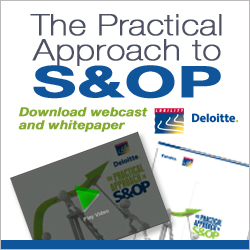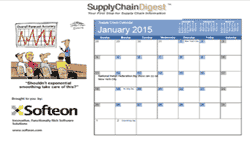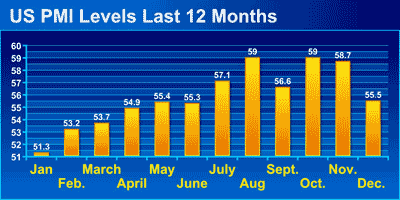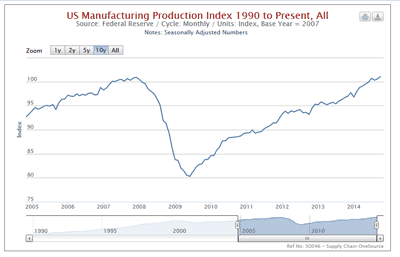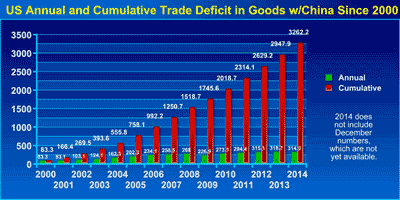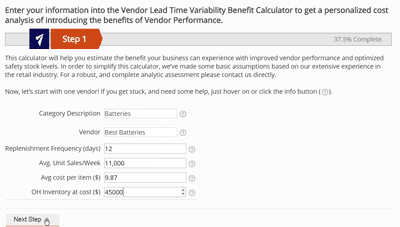 |
January 22, 2015 - Supply Chain Flagship Newsletter |
 |
| FEATURED SPONSOR: LOGILITY |
||
 |
||
|
||
 |
|
|||||||||||||||||||||||||||||||||||||||||||||||||||||||||||||||||||||||||||||||||||||||||||||||||||||
So let's get right to it! The Purchasing Managers Index, which measures manufacturing activity, was modestly above the 50 mark that separates expansion from contraction early in 2014, then generally gained strength as the year went on, twice reaching a very robust level of 59 in what is now a 19 month string of positive manufacturing growth, as shown in the chart below.
The new orders index - a barometer of future manufacturing activity - was also strong for most of the year, reaching an amazing level of 66 in November before falling to a still respectable 57.3 in December.
The PMI data was generally consistent with manufacturing production levels as reported each month by the Federal Reserve. The important news was that finally, in July, the manufacturing output index reached the 100 level that represents the peak and baseline year of 2007 - some seven years later. It stayed there for the rest of the year as well, and was 2.5% over 2007 levels (and up 4.9%, year over year) in December. As can be seen in the chart below, the index hit bottom in June 2009 at a level of about 81, and climbed slowly but steadily from there, showing just how bad the recession really was.
While the overall manufacturing index moved above the 2007 peak, there are huge differences in that recovery by sector, with industries such as autos, food and believe it or not electronics well above 2007 levels, while chemicals (surprising), furniture, consumer durables, and many others are lower today than in 2007, in some cases significantly so. Rising commodity and "input" costs were a huge issue for companies for most of the first decade of the 2000s. While the great recession set that back a bit, most input costs started to rise sharply again in 2010, before starting a three-year slide in 2011 in a change that surprises many. That commodity and input cost collapse continued in 2011, primarily in the second half of the year, lead of course by the plunge in oil prices, but nearly all other commodities fell sharply as well (some categories of meat were an exception), driven down by a strong US dollar and weak overall global demand. This can be seen in the commodity numbers chart from Canada's Scotiabank. Scotiabank's overall index was down 6.1%, metals were down 10.4%, forest products down 4.1% and agricultural commodities down 3% year over year. All those categories saw further declines in December.
I believe the collapse in oil prices was actually the top supply chain story of the year, as the ramifications from this - if it lasts, which I believe it will for some time - are many and profound. The amazing 2014 story on oil prices is illustrated below, as prices moves below $50 per barrel in early 2015.
Gasoline prices at the pump moved downward in proportion to the decline in oil, below $2 per gallon in many regions. However, shippers didn't see anywhere near the same level of relief, however, in large part because rising freight volumes kept diesel demand at refineries strong, with diesel nationally at $3.21 per gallon a the end of the year, down about 20% from the peak of $3.97 in March. But the price has move downward in 2015, to just $2.93 last week. US intermodal carload growth set record after record in 2014, as that freight migration continues on. Intermodal volumes were up a strong 5.2% on the year. Global trade growth continues to trend down, surprising to many of us, coming in at just 2.6% in 2014, according to the World Bank. That's up from 2.1% in 2013, but far below the 5-7% rate we saw before the recession. It is expected to rise to 3% this year. Growth rates in the emerging markets economies heavily targeted by global businesses are also slowing, in part due to the drop in commodity prices - meaning the extreme hope many multinationals have in finding salvation in emerging markets may turn out to be misplaced.The World Bank says growth in developing economies in 2014 was 4.4% in 2014, again down from what we often saw in the years before the recession. The US trade deficit rose 5.1% through November, to a total of $461 billion, even as oil imports slowed dramatically. Of course, the story was even worse for "goods," where the trade deficit was an astounding $673 billion through November, another record pace. Roughly half of that deficit in goods is in trade with China, where the deficit was $314 billion through November, and will again set a new record for the year. The cumulative US trade deficit with China in goods since 2000 is now some $3.2 trillion, as shown in the graphic below.
The growth of ecommerce sales rolled on, up 15.5%, 15.8% and 16.2% in Q1 through Q3 respectively year over year. As we await the Q4 number from the Commerce Dept, with Q3 internet sales of about $78 billion. That is still under 10% of total retail sales (and there are different ways to calculate that percentage), but ecom's share is obviously much higher in some categories. Amazon's growth has also slowed, as it faces the law of big numbers, but it still cranked out revenue increases in the 20-22% range in 2014, and will end the year with revenue of some $95 billion when it reports at the end of the month. Still, it can't make a profit, with an operating loss of $544 million on $20.6 billion in sales in Q3.
Overall retail sales were up 3.8% for the year, including inflation. I have lots more but am out of space. Also see our 2014 supply chain timeline of the year's top stories and events. Any reaction to our review of supply chain 2014 in numbers and charts? Is it of interest to you? Let us know your thoughts at the Feedback button below.
|
||||||||||||||||||||||||||||||||||||||||||||||||||||||||||||||||||||||||||||||||||||||||||||||||||||||
|
||||||||||||||||||||||||||||||||||||||||||||||||||||||||||||||||||||||||||||||||||||||||||||||||||||||
|
||||||||||||||||||||||||||||||||||||||||||||||||||||||||||||||||||||||||||||||||||||||||||||||||||||||
|
|
|
YOUR FEEDBACK
As promised, more emails from our First Thoughts piece on What Would You Tell Accountants about Supply Chain? Parts 1 and 2.
There were such a number of good ones, we are again not going to select a Feedback of the Week, but will rather just publish a few of the better ones thins week and next.
Feedback on What Would You Tell Accountants about Supply Chain?:
In 2013, I gave a talk to the Illinois CPA Society on inventory. I asked myself the same question that you did - how in my case can I make inventory interesting to CPA's and what should I suggest they do to influence it. |
||
I've been using a version of the DuPont model since the seventies. The version I was exposed to was called the Strategic Profit Model (SPM), but it is the same thing. I believe I was first exposed to it in a seminar put on by Dr. Bud LaLonde of Ohio State. To me, it is one of the most valuable tools around, both for finance people and for those of us in supply chain.
To an extent, I've had similar experiences to yours where I got a lot of blank stares from finance people. When I asked if they were familiar with the model, many have indicated they were unaware of it. I think one of the problems, is that the model has typically been presented as a generic model, showing relationships, but void of any data. That makes it abstract. However, when you load it with real data, the financial picture of organizations comes into view in an easily comprehensible way. In one company I worked for, we shared detailed financial information with all of our employees. Using the SPM, we not only shared the data with the employees, but they were able to track their individual job/work efforts all the way to Net Profit and ROI. They got it!
David Armstrong
|
SUPPLY CHAIN TRIVIA ANSWER
Q: How many container ships sail the ocean blue?
A: Exactly 5961 active ships right now, according to figures from Alphaliner.
| © SupplyChainDigest™ 2003-2015. All Rights Reserved. SupplyChainDigest PO Box 714 Springboro, Ohio 45066 |
POWERED BY: XDIMENSION
|


